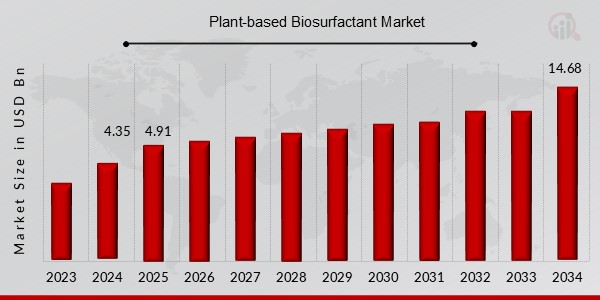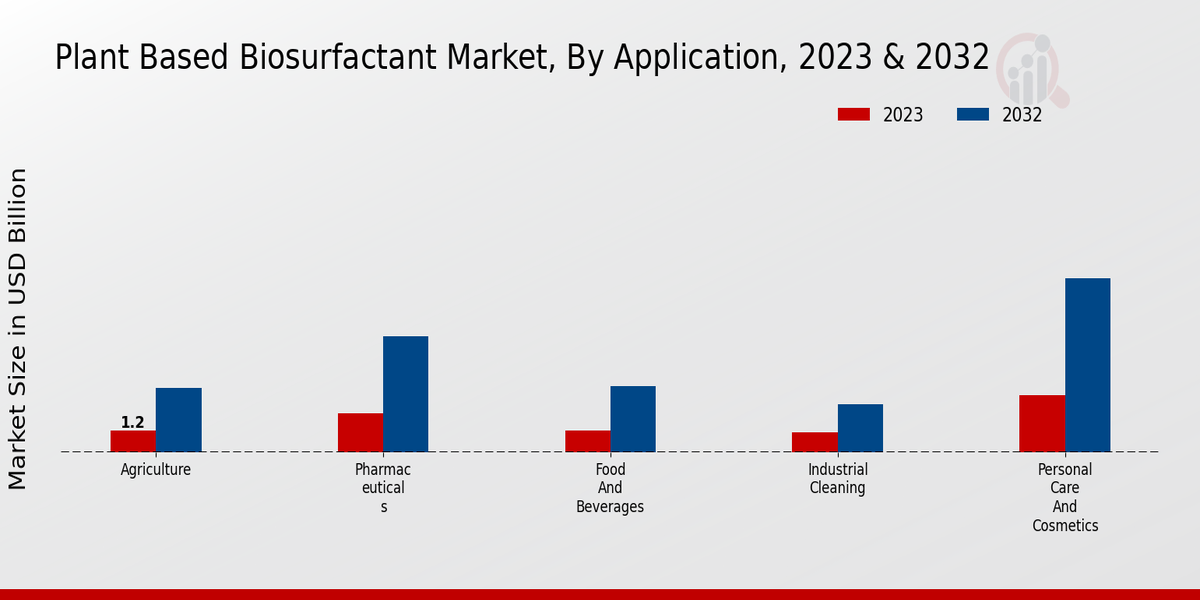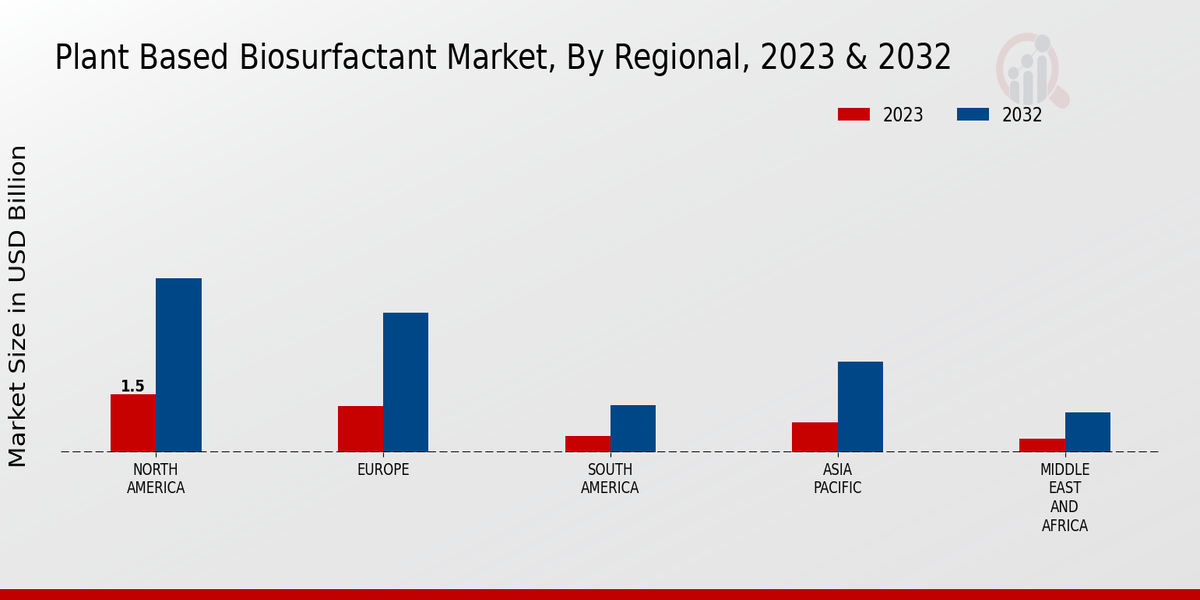Global Plant-based Biosurfactant Market Overview
The Plant-based Biosurfactant Market Size was estimated at 4.35 (USD Billion) in 2024. The Plant-based Biosurfactant Industry is expected to grow from 4.91 (USD Billion) in 2025 to 14.68 (USD Billion) by 2034. The Plant-based Biosurfactant Market CAGR (growth rate) is expected to be around 12.9% during the forecast period (2025 - 2034).
Key Plant-based Biosurfactant Market Trends Highlighted
Increasing environmental awareness and the growing demand for sustainable products are driving the growth of the plant-based biosurfactant market.
Key market drivers include the increasing use of biosurfactants in various industries, such as food and beverage, personal care, and pharmaceuticals, as well as the rising demand for eco-friendly alternatives to synthetic surfactants.
Opportunities for growth in the plant-based biosurfactant market include the development of new applications in emerging markets, such as bioremediation and agriculture. Additionally, advancements in biotechnology and the discovery of novel plant-based biosurfactants with enhanced properties present significant growth opportunities.
Recent trends in the plant-based biosurfactant market include the increasing use of genetically modified organisms (GMOs) to produce biosurfactants with specific characteristics, as well as the development of sustainable production processes to reduce environmental impact.
Moreover, the rising demand for plant-based biosurfactants from the food and beverage industry, driven by consumer preferences for natural and healthy products, is expected to further fuel market growth.

Source Primary Research, Secondary Research, MRFR Database and Analyst Review
Plant-based Biosurfactant Market Drivers
Increasing Demand for Environmentally Sustainable Products
Consumers are becoming increasingly aware of the environmental impact of their purchasing decisions, and this is driving demand for plant-based biosurfactants. Plant-based biosurfactants are biodegradable and non-toxic, making them a more sustainable alternative to traditional surfactants.
In addition, plant-based biosurfactants are often derived from renewable resources, which further reduces their environmental impact. The growing demand for environmentally sustainable products is expected to be a major driver of growth for the plant-based biosurfactant market in the coming years.
Plant-based biosurfactants offer several advantages over traditional surfactants, including their biodegradability, non-toxicity, and renewability. These advantages make plant-based biosurfactants an attractive option for a wide range of applications, including personal care, household cleaning, and industrial cleaning.
The growing demand for plant-based biosurfactants is being driven by a number of factors, including Increasing consumer awareness of the environmental impact of traditional surfactants, Growing demand for natural and organic products, Stringent government regulations on the use of traditional surfactants, Technological advancements in the production of plant-based biosurfactants. The plant-based biosurfactant market is expected to grow significantly in the coming years, driven by the increasing demand for environmentally sustainable products.
The market is also expected to benefit from the growing demand for natural and organic products, as well as the stringent government regulations on the use of traditional surfactants. Technological advancements in the production of plant-based biosurfactants are also expected to contribute to the growth of the market.
Rising Demand from the Personal Care Industry
The personal care industry is a major consumer of surfactants, and the demand for plant-based biosurfactants in this industry is growing rapidly. Plant-based biosurfactants are used in a wide range of personal care products, including shampoos, conditioners, soaps, and cosmetics.
They are valued for their mildness, non-irritating properties, and ability to improve the appearance and feel of the skin and hair. The rising demand for plant-based biosurfactants from the personal care industry is expected to be a major driver of growth for the plant-based biosurfactant market in the coming years.
Growing Adoption in the Food and Beverage Industry
The food and beverage industry is another major consumer of surfactants, and the demand for plant-based biosurfactants in this industry is also growing rapidly. Plant-based biosurfactants are used in a variety of food and beverage applications, including as emulsifiers, stabilizers, and foaming agents.
They are valued for their ability to improve the texture, appearance, and shelf life of food and beverage products. The growing adoption of plant-based biosurfactants in the food and beverage industry is expected to be a major driver of growth for the plant-based biosurfactant market in the coming years.
Plant-based Biosurfactant Market Segment Insights
Plant-based Biosurfactant Market Application Insights
The Plant-based Biosurfactant Market is segmented based on application into Pharmaceuticals, Personal care and cosmetics, Food and beverages, Agriculture, and Industrial cleaning. Among these segments, the pharmaceuticals segment is expected to hold the largest market share over the forecast period.
The increasing demand for plant-based biosurfactants in the pharmaceutical industry for the production of vaccines, antibiotics, and other drugs is driving the growth of this segment. The personal care and cosmetics segment is also expected to witness significant growth due to the rising demand for natural and sustainable products in the cosmetics industry.
The Food and beverages segment is expected to grow at a steady pace due to the increasing use of plant-based biosurfactants as emulsifiers, stabilizers, and foaming agents in food and beverage products. The agriculture segment is expected to witness moderate growth due to the potential of plant-based biosurfactants to improve soil health and plant growth.
The Industrial cleaning segment is expected to grow at a slow pace due to the availability of cheaper synthetic surfactants in the market. The Plant-based Biosurfactant Market is expected to witness significant growth over the forecast period due to the increasing demand for sustainable and environmentally friendly products.
The growing awareness of the harmful effects of synthetic surfactants on the environment is driving the demand for plant-based biosurfactants.
The increasing demand for natural and organic products in various industries, such as pharmaceuticals, personal care and cosmetics, food and beverages, and agriculture, is also contributing to the growth of the market.

Source Primary Research, Secondary Research, MRFR Database and Analyst Review
Plant-based Biosurfactant Market Raw Material Insights
The Plant-based Biosurfactant Market is segmented based on Raw Material into Vegetable oils, Sugars, Yeast extract, and Microalgae. In 2023, the Vegetable oils segment held the largest market share of around 45%, owing to the high availability and low cost of vegetable oils such as palm oil, soybean oil, and coconut oil.
Moreover, vegetable oils are biodegradable and have good foaming properties, making them suitable for various applications in the food and beverage, personal care, and pharmaceutical industries. The Sugars segment is projected to witness significant growth during the forecast period due to the increasing demand for plant-based surfactants in the food and beverage industry.
Sugars are used as a substrate for the production of biosurfactants, and they offer advantages such as low toxicity and high biodegradability. The Yeast extract segment is expected to hold a steady market share over the forecast period.
Yeast extract is a rich source of amino acids and vitamins, and it is used as a nutrient source for the production of biosurfactants. The Microalgae segment is anticipated to gain traction during the forecast period due to the growing focus on sustainable and eco-friendly surfactants.
Microalgae are a renewable resource that can be used to produce biosurfactants with unique properties, such as high emulsifying and foaming abilities.
Plant-based Biosurfactant Market Function Insights
The Function segment of the Plant-based Biosurfactant Market is expected to grow significantly in the coming years. In 2023, the market for emulsifiers was valued at USD 1.24 billion and is projected to reach USD 2.57 billion by 2032, exhibiting a CAGR of 9.2%.
Foaming agents held a market value of USD 0.87 billion in 2023 and are anticipated to reach USD 1.82 billion by 2032, growing at a CAGR of 9.8%. Dispersants, valued at USD 0.72 billion in 2023, are expected to reach USD 1.51 billion by 2032, expanding at a CAGR of 9.1%.
Solubilizers, with a market value of USD 0.61 billion in 2023, are projected to reach USD 1.29 billion by 2032, growing at a CAGR of 9.4%.
The growth of the Function segment is attributed to the increasing demand for plant-based biosurfactants in various industries, including food and beverage, personal care, and pharmaceuticals.
Emulsifiers, foaming agents, dispersants, and solubilizers are key functional ingredients that enhance the stability, texture, and performance of products in these industries. The rising consumer preference for natural and eco-friendly products is also driving the demand for plant-based biosurfactants.
Plant-based Biosurfactant Market Regional Insights
The Plant-based Biosurfactant Market is segmented into North America, Europe, APAC, South America, and MEA. North America held the largest market share in 2023 and is expected to maintain its dominance throughout the forecast period.
The growth of the North American market is attributed to the increasing demand for plant-based products, the growing awareness of the environmental benefits of plant-based surfactants, and the presence of major players in the region. Europe is the second-largest market for plant-based biosurfactants and is expected to grow at a significant rate during the forecast period.
The growth of the European market is attributed to the increasing demand for sustainable products, the stringent environmental regulations, and the presence of well-established personal care and cosmetic industries. APAC is the fastest-growing market for plant-based biosurfactants and is expected to witness the highest growth rate during the forecast period.
The growth of the APAC market is attributed to the increasing demand for plant-based products, the growing awareness of the environmental benefits of plant-based surfactants, and the presence of a large population base.

Source Primary Research, Secondary Research, MRFR Database and Analyst Review
Plant-based Biosurfactant Market Key Players and Competitive Insights
Major players in the Plant-based Biosurfactant Market are focused on expanding their product portfolios and increasing their production capacities. They are also investing in research and development to introduce new and innovative products.
The Plant-based Biosurfactant Market industry is characterized by the presence of a few large players and a number of small and medium-sized players. The leading Plant-based Biosurfactant Market players are investing in research and development to improve the performance of their products and to develop new applications.
They are also expanding their geographical reach by establishing new production facilities and distribution channels. The Plant-based Biosurfactant Market is expected to witness significant growth in the coming years, driven by the increasing demand for eco-friendly and sustainable products.
Ecover is a leading company in the Plant-based Biosurfactant Market. The company offers a wide range of plant-based biosurfactants, including rhamnolipids, sophorolipids, and mannosylerythritol lipids. Ecover's biosurfactants are used in a variety of applications, including personal care, household cleaning, and industrial cleaning. The company has a strong focus on sustainability and is committed to reducing its environmental impact.
BASF is a leading competitor in the Plant-based Biosurfactant Market. The company offers a wide range of plant-based biosurfactants, including alkyl polyglucosides, fatty acid esters, and sugar esters. BASF's biosurfactants are used in a variety of applications, including personal care, household cleaning, and industrial cleaning.
The company has a strong presence and is committed to providing high-quality products and services to its customers.
Key Companies in the Plant-based Biosurfactant Market Include
- Earth Friendly Products
- Seventh Generation
- Aunt Fannie's
- method
- Ecover
- Biokleen
- Puracy
- Method
- Green Works
- Better Life
Plant-based Biosurfactant Market Industry Developments
The Plant-based Biosurfactant Market is poised to expand rapidly, driven by growing demand for eco-friendly and sustainable products. The growth can be attributed to increasing awareness about the harmful effects of synthetic surfactants and the rising adoption of plant-based ingredients in various industries.
Furthermore, government regulations promoting the use of biodegradable and environmentally friendly products are expected to drive market expansion. Recent developments include the launch of new products by key players and strategic collaborations to enhance production capacity.
For instance, in 2023, Evonik Industries AG announced the expansion of its plant-based biosurfactant production facility in Germany to meet the growing demand for sustainable solutions.
Plant-based Biosurfactant Market Segmentation Insights
- Plant-based Biosurfactant Market Application Outlook
- Pharmaceuticals
- Personal care and cosmetics
- Food and beverages
- Agriculture
- Industrial cleaning
- Plant-based Biosurfactant Market Raw Material Outlook
- Vegetable oils
- Sugars
- Yeast extract
- Microalgae
- Plant-based Biosurfactant Market Function Outlook
- Emulsifiers
- Foaming agents
- Dispersants
- Solubilizers
- Plant-based Biosurfactant Market Regional Outlook
- North America
- Europe
- South America
- Asia Pacific
- Middle East and Africa
| Report Attribute/Metric |
Details |
| Market Size 2024 |
4.35 (USD Billion) |
| Market Size 2025 |
4.91 (USD Billion) |
| Market Size 2034 |
14.68 (USD Billion) |
| Compound Annual Growth Rate (CAGR) |
12.9% (2025 - 2034) |
| Report Coverage |
Revenue Forecast, Competitive Landscape, Growth Factors, and Trends |
| Base Year |
2024 |
| Market Forecast Period |
2025 - 2034 |
| Historical Data |
2020 – 2024 |
| Market Forecast Units |
USD Billion |
| Key Companies Profiled |
Earth Friendly Products, Seventh Generation, Aunt Fannie's, method, Ecover, Biokleen, Puracy, Method, Green Works, Better Life |
| Segments Covered |
Application, Raw Material, Function, Regional |
| Key Market Opportunities |
Growing demand for eco-friendly products Biodegradable and sustainable nature Expansion of the personal care and cosmetics industry Increasing awareness of health benefits Potential in the food and beverage industry |
| Key Market Dynamics |
Rising environmental concerns Increased demand for the cosmetic industry Growing adoption in the food and beverage industry Technological advancements in production Expanding applications in the oil and gas industry |
| Countries Covered |
North America, Europe, APAC, South America, MEA |
Frequently Asked Questions (FAQ) :
The Plant-based Biosurfactant Market is expected to reach USD 14.68 billion by 2034, exhibiting a CAGR of 12.9% from 2025 to 2034.
North America and Europe were the dominant regions in the Plant-based Biosurfactant Market, collectively accounting for over 60% of the market share in 2024.
The major consuming industries of Plant-based Biosurfactants include oil and gas, personal care and cosmetics, food and beverage, and pharmaceuticals.
Key players in the Plant-based Biosurfactant Market include Ecogreen Oleochemicals, Rhamnolipid, Jeneil Biosurfactant Company LLC, and AGAE Technologies LLC.
Rising environmental concerns, increasing demand for bio-based and sustainable products, and growing applications in various industries are driving the growth of the Plant-based Biosurfactant Market.
High production costs, limited availability of raw materials, and competition from synthetic surfactants are some of the challenges faced by the Plant-based Biosurfactant Market.
Growing awareness about the benefits of plant-based biosurfactants, technological advancements, and increasing government support for sustainable practices are creating opportunities for the Plant-based Biosurfactant Market.
The Plant-based Biosurfactant Market is projected to grow at a CAGR of 12.9% from 2025 to 2034.
Key trends in the Plant-based Biosurfactant Market include the development of novel production technologies, increasing demand for eco-friendly products, and the expansion of applications in emerging industries.
Key application segments of the Plant-based Biosurfactant Market include enhanced oil recovery, bioremediation, personal care, food processing, and pharmaceuticals.
















